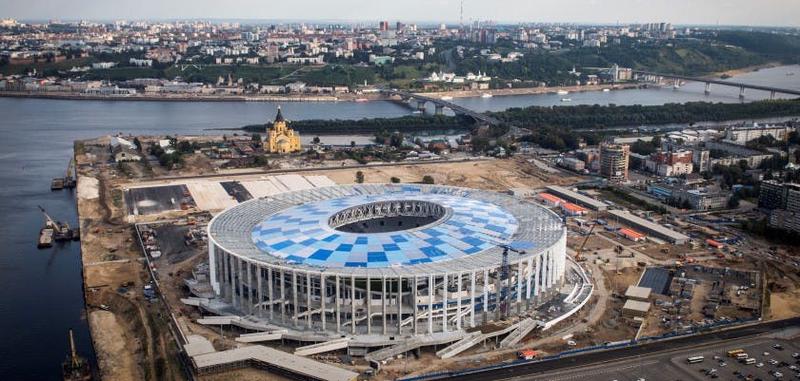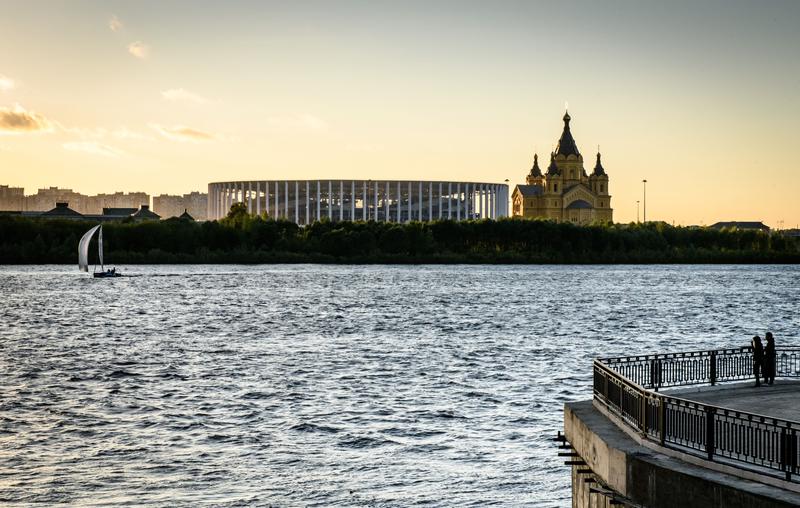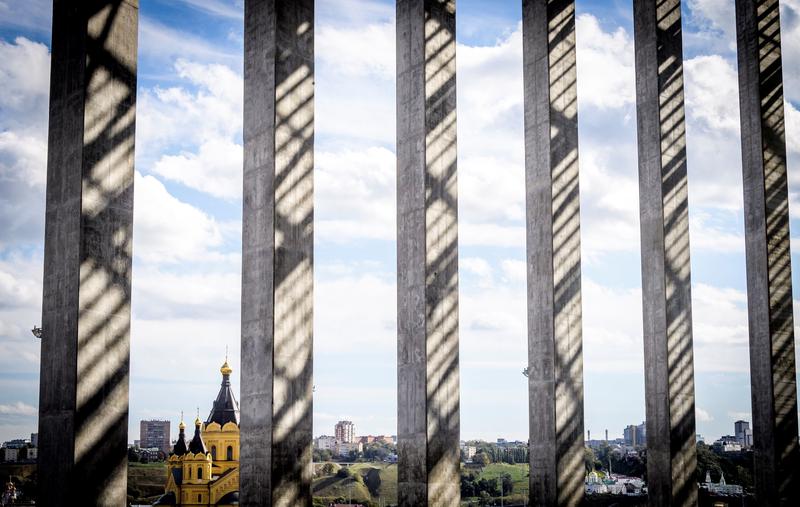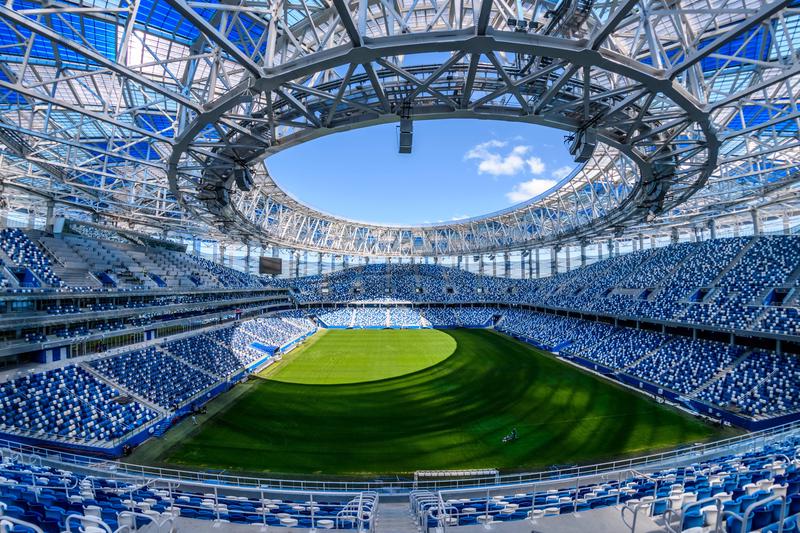The Nizhny Novgorod Stadium fits perfectly into the historical landscape of the city that houses the Kremlin.

This piece is the second in a series in which we will analyze the most beautiful stadiums of the Russian World Championship. The first was the Otkritie Arena in Moscow, and in case you missed it, you can find it here...
At Nizhny Novgorod Stadium were played the following games:
Sweden-South Korea (Group F), 18 June 2018
Argentina-Croatia (Group D), 21 June 2018
England-Panama (Group G), 24 June 2018
Switzerland-Costa Rica (Group E), 27 June 2018
Switzerland-Costa Rica (Group E), 27 June 2018
And they will be played:
Last sixteen 1D-2C, July 1, 2018
Last eight 1A-2B/1C-2D, July 6, 2018
The city of Nizhny Novgorod shines between the blue sky and the blue waters of the Volga River, which bathes it from north to south. The green of the pyramidal roofs of the 13 towers of the Kremlin fortress, stand out against the red of the bricks and the grey of the stone that surround the structure of the most important building in local history.
But Nizhny Novgorod hasn't always been like that. From 1959 to 1991 it was a "closed city", one of those locations of the Soviet Union forbidden to foreign visitors and, often, with severe limitations even for the very residents of other parts of the country (there are still today, it is estimated that about forty). These cities were strategic points for sending mail (collected under a cold but explanatory list entitled "P.O. Boxes" and called Zato - Russian acronym of closed territorial-administrative formations) or industrial production centers for war purposes. In Nizhny Novgorod, for example, since 1929 there has been the largest car factory in the country and, during the Second World War, it had become the largest supplier of war material to the front - and consequently one of the primary targets for the German Luftwaffe.
But Nizhny Novgorod's history, more than the project of "closed cities", is linked to the enormous fortress it houses: the Kremlin.
Architecture and football in Nizhny Novgorod
Built in stone between 1508 and 1515 by the Italian architect Pietro Francesco (of whom few chronicles report the activity in the service of the Russian sovereign Basil III), the Kremlin has accompanied the history of Nizhny Novgorod, since its first wooden version dated 1221 - when it served as the first fortification on the occasion of the founding of the city. Inside the fortress stands the Cathedral of the Archangel Michael, the only church that survived among those who populated the Kremlin in the past. The white of the stone with which it was built, stands out with the daylight and contrasts with the green roofs that recall the architectural influences of the central European castles, which contrast with the Baroque of the most famous Russian buildings.
The Kremlin fortress watches over the southern side of the city from the confluence of the Volga and Oka rivers. The latter comes from the far west, where Ukraine can be seen on sight, and once arrived in Nizhny Novgorod plunges into the Volga in the shade of the Cathedral of Alexander Nevsky. We are on the other side of the Kremlin, and this is where rises the Nizhny Novgorod Stadium, one of the 12 facilities that will host the World Cup in Russia 2018.

Football in Nizhny Novgorod is linked to the adventures of FC Volga, the most important club in the city. It was founded in 1963 as a result of the fusion of Torpedo and Raketa when the city was still called Gorky, in honor of Maksim Gorky, the famous Russian playwright who was born here in 1868. FC Volga, who will never manage to get out of a grey mediocrity of results throughout his life, will not have time to see the city change name and fail in 1984, six years before Gorky became Nizhny Novgorod.
FC Volga was reborn for the first time in 1998 as FC Elektronika and then resumed its original name in 2004. In 2016, however, it failed a second time, strangled by debts incurred in the previous ten years and the impossibility of paying them back with the modest position of middle ranking in the second division.
Since the previous year professional football has returned to the city with the FC Volga-Olympiyets, promoted in the third league. But above all the construction of the Nizhny Novgorod Stadium begins in view of the World Cup.
The architecture of the Nizhny Novgorod Stadium
If the Otkritie Arena in Moscow is a stadium that represents the symbolism of its club, and the Cosmos Arena is a celebration of Soviet history and its space achievements, the stadium in Nizhny Novgorod is a building representative of the city and its architecture.
The isolated position makes the building stand out even more from the rest of the city: located in an area of about 40 hectares, free from buildings, on the curve of the confluence between Volga and Oka, it manages to communicate perfectly with the architecture of the Cathedral of Aleksandr Nevsky, on the bank of the river less than 500 meters away.
The yellow-ochre of the orthodox cathedral and the eclecticism of its forms, which combine neo-classical, neo-gothic and baroque flashes, counterbalance the white and blue that traces the outer cylinder of the stadium, marked by thin triangular-section pillars that support the flat disc of the roof. The Nizhny Novgorod Stadium not only respects the presence of the cathedral but at the same time creates a contrast of forces that gives even more prominence to the orthodox building, proudly confident of itself in facing the new neighbor.

The 88 reinforced concrete pillars that surround the building create the vertical weave of a colonnade that recalls classical architecture and wraps around the stadium, rising on a podium access to the internal tribunes. The immobility of the external structure contrasts with the theme of movement, which is typical of the innermost heart of the stadium. The bowl of the stairs is, in fact, an internal block protected and screened by external pillars. The stairs that lead to the podium, from the square, create a vortex effect just mentioned, in a "total white" that camouflages the building in winter snow.
The vortex effect is emphasized by the blue of the internal ramps, which lead directly to the grandstands. The contrast of these diagonal signs chasing each other, with the external vertical pillars, is decisive in giving strength to the building. The flow of water from the Volga River is also brought to the observer's attention by semi-transparent metal sails alternating in blue and white, shielding the voids at the top of the stadium, between the second ring and the roof.
The stadium can host 45,000 people and its construction was contracted to the Russian company Stroytransgaz - active particularly in civil engineering and industrial buildings, and also responsible for the construction of the Volgograd Stadium for the 2018 World Cup. Built within three years, it cost almost €250 million. Its stands are divided into two rings, separated by an intermediate band with two floors that houses the stages and VIP places. The second ring ends with the usual sinusoidal profile (called "the ola") that allows you to optimize the distance of view of the field from any seat.
Blue is the color of the interior of the stadium, as white is the color of the exterior. The entrance walls for each sector and all the service blocks (such as stairs and lifts) are highlighted in blue, which is further declined in various shades of blue and light blue in the color of the seats.
The flat covering disc leaves an oval oculus open on the field and is covered with a fantasy of semi-transparent polycarbonate panels, in shades of blue and azure, visible on both sides. The roof support structure consists of a network of steel trusses, weighing a total of 10,000 tons, and the entire roof covers an area of 57,000 square meters.

The continuous dialogue of chromatic tonalities defines the Nizhny Novgorod Stadium as a facility that fits in the best way even in the city context, almost camouflaging itself in winter, when the city and the Volga river are covered in white snow.
Despite being very similar to the Estádio Nacional Mané Garrincha in Brazil, which hosted some matches of the World Cup 2014, the stadium in Nizhny Novgorod is a stadium that has its own very clear communicative power: fits perfectly into the historical landscape of the city (its height does not exceed 87 meters of the nearby Cathedral of Alexander Nevsky), celebrates the characteristics and natural identity of the region, and dialogues with the classicism of other historic buildings in a continuous contrast that brings out its contemporary style.
This is it for the Nizhny Novgorod, if you enjoyed reading my post don't forget to upvote and follow me for more!
In case you missed my post about the Otkritie Arena just click here!
Comments